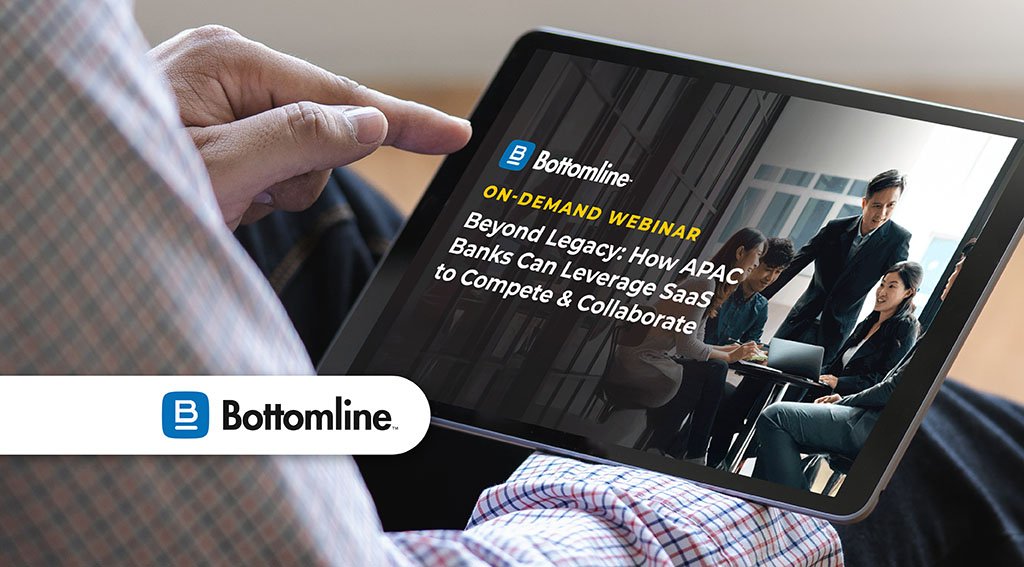As the global banking sector moves rapidly to embrace SaaS, APAC institutions face a tougher path.
Legacy systems, complex regulatory environments and regional fragmentation continue to slow adoption.
Yet the opportunity is clear: SaaS offers a scalable, future-ready foundation for growth.
In a recent webinar, B2B payments service provider Bottomline brought together regional experts to discuss how banks in APAC can close the gap and compete more effectively.
Conservatism vs. Transformation: Understanding the Hesitation
Webinar panellist Damien Dugauquier, Co-founder and CEO of International Payment Identity (iPiD), highlighted a persistent conservatism among traditional APAC banks when it comes to SaaS adoption.
“Our only on-premise customers are in APAC,” he shared, contrasting this with the rapid deployment cycles of digital-first banks and fintechs in the region.
Resistance, he explained, stems not from lack of interest but from genuine regulatory hurdles, particularly data sovereignty concerns and a lack of clarity around compliance frameworks. Yet this is starting to shift.
Thanks in part to the efforts of global cloud providers like Google Cloud and Microsoft, who are engaging regulators and establishing local data centres, the foundational infrastructure for SaaS in APAC is gaining traction.
Beyond System Upgrades: Reimagining Practice, Not Just Platforms
According to Sadiq Javeri, Head of Platform Product Management at Bottomline, moving to SaaS is more than just replacing legacy infrastructure.

“It’s possible to upgrade your systems and still operate as if nothing has changed,” he noted.
He added that “SaaS is not only a technology but also a way of delivering services,” which means banks need to rethink how they operate, not just the systems they use.
To realise the full benefits of SaaS, institutions must:
• Treat vendors as strategic partners, not just service providers
• Use agile workflows to deliver updates more quickly
• Prioritise accurate, consistent data to support analytics, AI and fraud prevention
Without these changes, even the best technical upgrades risk underdelivering.
Why SaaS Matters Now: The Pressure to Modernise
The adoption gap is especially significant given APAC’s leadership in payment innovation.
As Dugauquier noted, the region leads in domestic real-time payments and is now driving instant cross-border innovation through central bank-led initiatives like Project Nexus and private-sector players such as Visa Direct and Thunes.
With the growth of real-time payment systems, the panel highlighted the increasing importance of fraud prevention.
While real-time rails aren’t inherently riskier, they require stronger safeguards.
Tools like account verification and behavioural and transactional monitoring, delivered through SaaS, are helping banks respond more effectively and protect their customers.
“Banks don’t have five years to build fraud solutions from scratch,” Dugauquier stressed. “SaaS lets them deploy quickly and stay ahead of increasingly sophisticated threats.”
The Role of Standards: ISO 20022 and the Power of Interoperability
Javeri described ISO 20022 as “not new, but the foundation” for future-ready payments.
He emphasised that the standard brings consistency and structure across payment rails, making it easier to plug in, aggregate and act on data in a scalable way.
“It enables interoperability and opens the door to building next-layer capabilities,” he said. “Things like analytics, AI and ultimately more intelligent and responsive customer experiences all start with structured data.”
Structured data, he added, also supports use cases like liquidity forecasting and embedded finance, where financial services can be accessed through third-party platforms such as ERP systems or business applications.
Customer Use Case: J Trust Royal Bank

Polo Chap, Manager, Swift & Quality Assurance at J Trust Royal Bank, provided a practical lens into how SaaS is already improving banking outcomes in Cambodia.
From 24/7 live chat and smart ATMs to eKYC-enabled onboarding and API integrations with fintech platforms like Bakong, the bank is actively leveraging technology to enhance customer experience.
SaaS partnerships also play a critical role in resilience and fraud mitigation. “With Bottomline, we’ve reduced turnaround time for issue resolution and enhanced system reliability,” Chap shared.
He pointed to disaster recovery and fraud protection as key areas of value.
Poll Insights: Pain Points and Priorities
Audience poll results during the webinar underscored the urgency of change:
• 44% cited legacy systems as their top obstacle to keeping pace with industry shifts
• 28% highlighted challenges in integrating with internal infrastructure
• 33% said SaaS would help drive end-to-end operational efficiency. This was followed by 26% who cited the ability to leverage a single multilateral payments platform, and 20% who prioritised speed to market
Despite these benefits, barriers remain. “Delaying migration is costing time more than money,” said Javeri. “And in a competitive landscape, that can be just as dangerous.”
Looking Ahead: A Roadmap for APAC Banks
Rather than large-scale overhauls, panellists advocated for a phased, use-case-driven approach to SaaS adoption.
Starting with focused workflows like payment verification, Dugauquier pointed to EU and UK mandates requiring pre-payment validation as a case in point.
“Regulation gave banks the budget and the urgency,” he said. “Now they’re building on that foundation to enhance fraud detection and compliance capabilities.”
The panel also cautioned against adopting AI without transparency.
While the technology is promising, Dugauquier noted that banks still need to explain and justify decisions made using automated tools. This is a critical requirement in regulated environments.
Final Thought: Learn Fast, Scale Smart
As the session wrapped up, the panellists reinforced that banks can move faster by learning from others.
SaaS gives financial institutions access to proven capabilities, secure infrastructure and industry expertise without having to build everything themselves.
“You don’t go far if you’re unwilling to share and learn,” said Dugauquier. “SaaS is about leveraging scale, not just in technology, but in knowledge.”
Watch the full on-demand webinar on Beyond Legacy: How APAC Banks Can Leverage SaaS to Compete & Collaborate.
Featured image: Edited by Fintech News Singapore, based on image by user6724086 via Freepik


